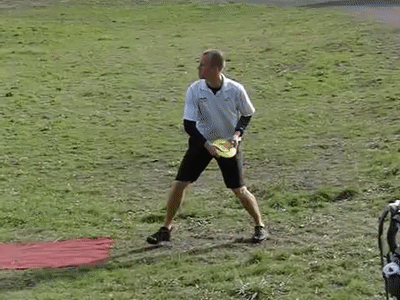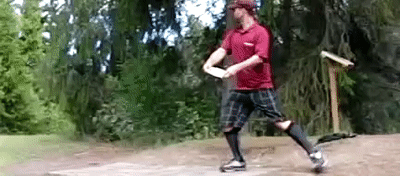I have nothing constructive to add.. Just that it's another great thread! Thanks boys and HUB for the kickoff! I'm learning more this fall than I've learned in years.
-
Discover new ways to elevate your game with the updated DGCourseReview app!
It's entirely free and enhanced with features shaped by user feedback to ensure your best experience on the course. (App Store or Google Play)
You are using an out of date browser. It may not display this or other websites correctly.
You should upgrade or use an alternative browser.
You should upgrade or use an alternative browser.
Shifting correctly makes bracing easy
- Thread starter HyzerUniBomber
- Start date
Fact - she's bowling righty, I mirrored the image.
I used to be a pretty decent bowler and I'm always confused as to what my rear leg shoulder be doing as I initiate the hit. Does my rear leg twist inward and I push off my my toes? That's what it seems like it should be doing... so ive been practing the bowler leg finish. Now it seems like the bowler leg finish is just your rear leg thrusting forward into and behind the front leg. And this thrusting forward of that rear leg seems to want to happen naturally when you go for elbow extension. But it seems like when you do this bowler thrust it doesn't increase the rotation of the body, it feels like it counteracts the rotation of the body. Is this how it should feel?
- Joined
- Nov 2, 2008
- Messages
- 21,978
Rear leg swivel(not twist) counters pelvis rotation to release upper body/arm/disc swing.
Rear leg swivel(not twist) counters pelvis rotation to release upper body/arm/disc swing.
Whats the difference between swivel and twist?
I'm trying this bowler finish, I really don't think the bowler leg thrust is what the Disc golf rear should be doing.
- Joined
- Nov 2, 2008
- Messages
- 21,978
Swivel is gliding - zero torque. Twist is jamming - torque.Whats the difference between swivel and twist?
I'm trying this bowler finish, I really don't think the bowler leg thrust is what the Disc golf rear should be doing.
Then don't do it.
- Joined
- Nov 2, 2008
- Messages
- 21,978
Swivel is effortless, smooth gliding leverage. Twist is jerking and jamming torque.Whats the difference between swivel and twist?
I'm trying this bowler finish, I really don't think the bowler leg thrust is what the Disc golf rear should be doing.
https://www.youtube.com/watch?v=Mpp7ZFLHK90#t=3m05
HyzerUniBomber
* Ace Member *
This video spun out of these conversations and RFrance suggested it should probably get posted in here too. Makes sense, thanks everyone for their great input.
Also created a new heavydisc post! That's unpossible!
crd 81
Double Eagle Member
- Joined
- Oct 16, 2007
- Messages
- 1,004
This video spun out of these conversations and RFrance suggested it should probably get posted in here too. Makes sense, thanks everyone for their great input.
Also created a new heavydisc post! That's unpossible!
Great video! You're a good teacher!
I too have suffered from a straight(ish) brace. I definitely need to be more intentional going into my brace at 20 degrees or so with my plant foot. Between you, sidewinder, and Brad, I'm able to see things that have and will work. Good stuff!
HyzerUniBomber
* Ace Member *
lots of weird discussion on facebook about that video
Oh fun, thankfully I quit the Facebook.
Watch how McBeth......]
Doesn't rotate one bit on the heal, but rotates primarily flat on the foot with just a touch of toe support as he leans forward a bit. None of that "toe first, flat, then rotate on heal" bs that's been going around for ages. Hell...he even collapses his right knee a bit as he releases. If this is the wrong way to do it, I'm fine being in the wrong all this time.
drk_evns
Eagle Member
I was the one "discussing" with Bradley on Facebook. He made the claim that Paige Pierce doesn't brace, got mad when I said she doesn't and that it's dangerous to discuss topics like that in a group filled mostly with beginners. I'm just sick of this new claim every week and needing to throw out old (and proven) concepts.
Telling people to drive with the rear side is one thing, but then telling them not to brace is too far.
Telling people to drive with the rear side is one thing, but then telling them not to brace is too far.
drk_evns
Eagle Member
"got mad when I said she doesn't"
I meant does.
I love this video by the way. Really great breakdown of the true core concept of using the brace to throw a light object like the disc.
I meant does.
I love this video by the way. Really great breakdown of the true core concept of using the brace to throw a light object like the disc.
Oh fun, thankfully I quit the Facebook.
lol
someone tried to tag you. In all honesty, it's just one person. Everyone else was very appreciative of the video (me included).
slowplastic
* Ace Member *
- Joined
- Jul 11, 2014
- Messages
- 6,254
Doesn't rotate one bit on the heal, but rotates primarily flat on the foot with just a touch of toe support as he leans forward a bit. None of that "toe first, flat, then rotate on heal" bs that's been going around for ages. Hell...he even collapses his right knee a bit as he releases. If this is the wrong way to do it, I'm fine being in the wrong all this time.
How is it BS if most people do that?
McBeth is known for collapsing his knee and being more on the toe on lower power shots, it seems to be the way he absorbs some power and gains consistency.
His rotation is through the outer part of the foot, like halfway up the foot...then his mass moves forward and he gets to the toes, yes.
Take a look at these shots to see all sorts of subtle variety, but noone on tippy toes:
-Ricky is toe-heel and rotates on heel then outer foot
-Kajiyama is toe-heel and rotates on heel
-Eagle is toe-heel and rotates on outer foot, centered
-McBeth is toe-heel and rotates on heel
osborne
Par Member
- Joined
- May 7, 2009
- Messages
- 234
Please stop mixing units, without some much fancier footwork lbs and kg cannot be used in the same formula like this, need to be consistent with either metric or English, lbs is a force, kg is a mass, metric equivalent of force is newton. This just hurts my head trying to follow this. Try this on for size, gravity is 10m/s/s, if you are falling for 1 s that means you are traveling at 10m/s. If we make an assumption that you stop moving in .1 s when you land your deceleration will be 10m/s/.1s or 100 m/s/s. If you weigh 10 kg and F=ma the force from falling comes out to 100m/s/s *10 kg = 1000 kg *m/s/s or 1000 Newtons. If you are standing statically, 10kg*10m/s/s (gravity)=100 kg*m/s/s or 100 newtons.
1. Distance/time dropped is squared... 9.81m/s^2 is meters per second per second. Let's just round off numbers and ignore air resistance for simplicity and say your static weight is 100lbs, and gravity is 10m/s^2, so your mass is not moving distance/time, so it is about 10kg = 100lbs divided by 10m/s^1.
If you drop for 1 second, your dynamic weight becomes 1,000lbs = 10kg x 10m/s(Gravity) x 10m/s(1 Gravity second). You won't drop 1 second though, but some of the horizontal momentum also is transformed through the bracing. IIRC Markus Kallstrom was measured on a force plate to have close to 1000lbs on his front foot during the swing.
2. Absolutely, but it's a smooth rhythmic extension, not a jerk. Otherwise you would be collapsing into the ground. Just to standstill upright and static without moving around you are actively extending your leg/legs. You may even appear to be collapsing while you are actively extending or trying to extend to break your fall because gravity is always accelerating you downward and then add in that extra acceleration from falling and you have to generate even more force to maintain some semblance of upright balance.


UhhNegative
Eagle Member
- Joined
- Mar 28, 2016
- Messages
- 950
It's the same concept/idea though. You are adding nothing to the discussion besides being a contrarian.Please stop mixing units, without some much fancier footwork lbs and kg cannot be used in the same formula like this, need to be consistent with either metric or English, lbs is a force, kg is a mass, metric equivalent of force is newton. This just hurts my head trying to follow this. Try this on for size, gravity is 10m/s/s, if you are falling for 1 s that means you are traveling at 10m/s. If we make an assumption that you stop moving in .1 s when you land your deceleration will be 10m/s/.1s or 100 m/s/s. If you weigh 10 kg and F=ma the force from falling comes out to 100m/s/s *10 kg = 1000 kg *m/s/s or 1000 Newtons. If you are standing statically, 10kg*10m/s/s (gravity)=100 kg*m/s/s or 100 newtons.
How is it BS if most people do that?
McBeth is known for collapsing his knee and being more on the toe on lower power shots, it seems to be the way he absorbs some power and gains consistency.
His rotation is through the outer part of the foot, like halfway up the foot...then his mass moves forward and he gets to the toes, yes.
You are correct it's not bs. I was just thinking about my personal journey with disc golf. Like I said, in that particular video, if that is bad form, then I'm ok with it.
- Joined
- Nov 2, 2008
- Messages
- 21,978
IMO toe/ball pivot is just not the best way for distance or your leg. Pivoting on the ball of the foot means your heel/ankle/knee and hip all have to go airborne and end up spinning back in toward your center/weight, and your whole center is orbiting around a point, slowing down your rotational speed.Doesn't rotate one bit on the heal, but rotates primarily flat on the foot with just a touch of toe support as he leans forward a bit. None of that "toe first, flat, then rotate on heal" bs that's been going around for ages. Hell...he even collapses his right knee a bit as he releases. If this is the wrong way to do it, I'm fine being in the wrong all this time.
If you pivot on the heel, your leg and center remain pivoting on a single point speeding up rotation and giving you a more stable base from which to throw from with your ankle supported by the ground. When you pivot on your heel your toes swing out of the way so you can remain centered without torquing the leg nearly as much.
Throwing golf shots(not for distance) things are going to vary more trying to shape shots and also the trajectory and your balance can affect whether you end up pivoting on your heel or ball of the foot. Many players including myself pivot on both the heel and ball, but just depends on the shot/balance, but I do feel more torque on the leg more when pivoting on the ball and try to avoid it, as that is also how I fractured my tibia way back when. You should be able to feel the difference just standing on one leg and swinging the arm and adjust your balance for pivot on toes vs heel.
Now check out Paul on a distance shot:

osborne
Par Member
- Joined
- May 7, 2009
- Messages
- 234
It's the same concept/idea though. You are adding nothing to the discussion besides being a contrarian.
Hey if your ok with the wrong answer that's your problem. I was just trying to help so the math actually worked out correctly. FYI in the real world if you mix units like that and don't correct for it bad things happen, google the mars rover incident.
Similar threads
- Replies
- 5
- Views
- 316
- Replies
- 16
- Views
- 2K
- Replies
- 10
- Views
- 2K